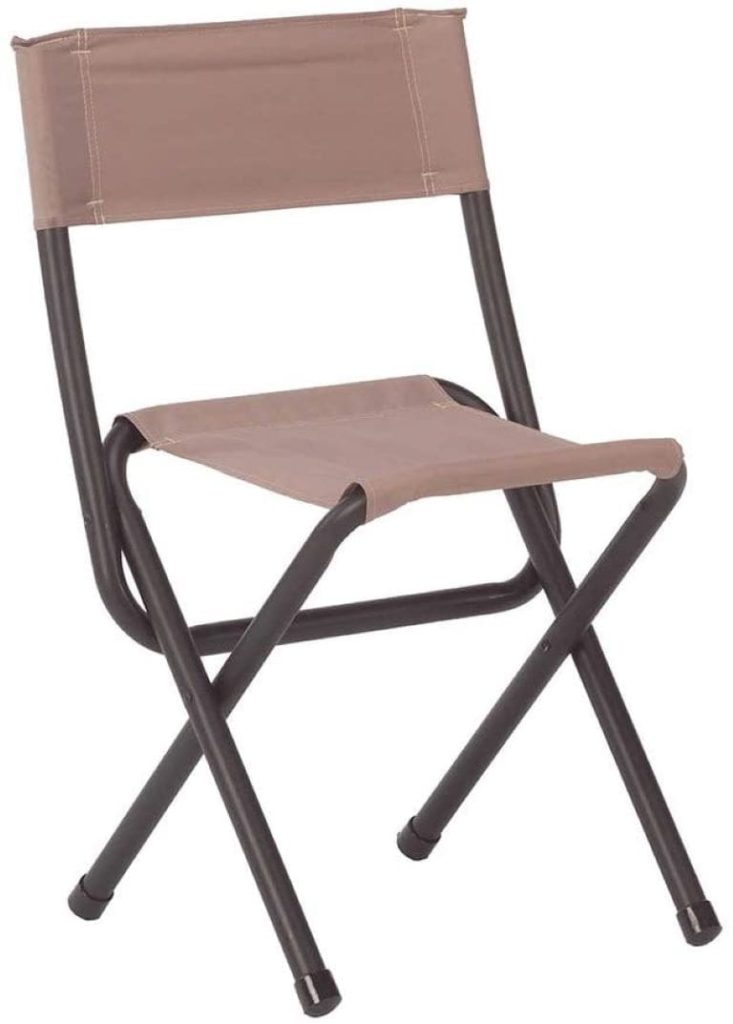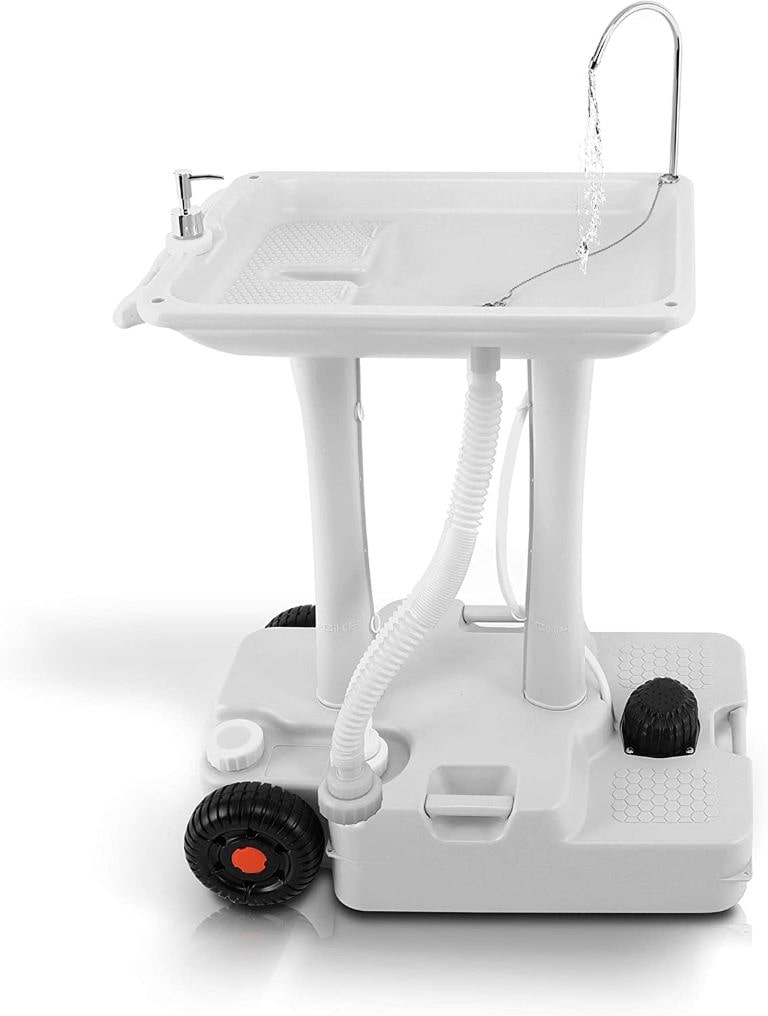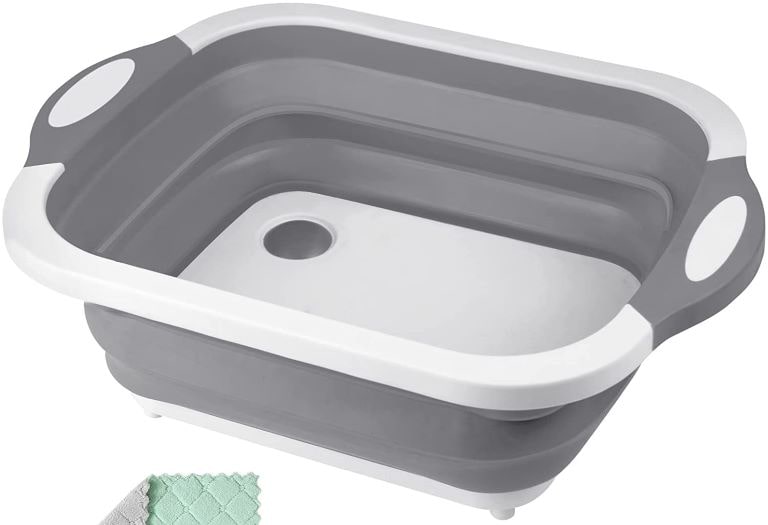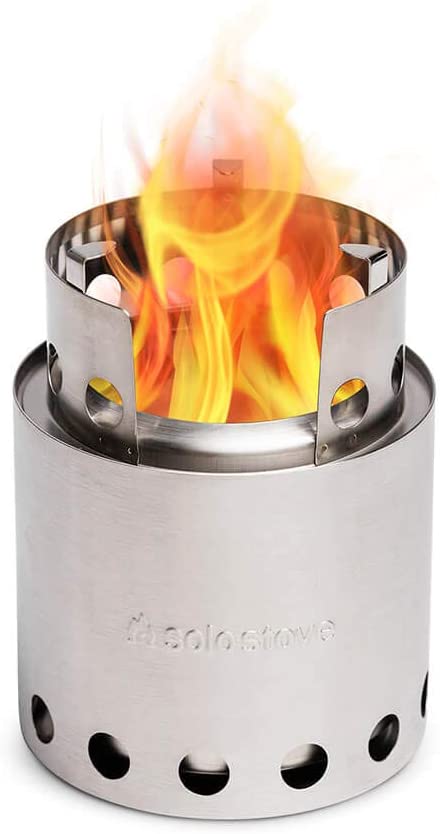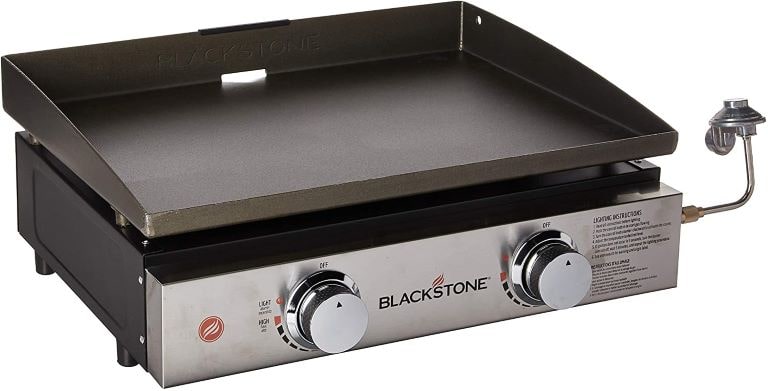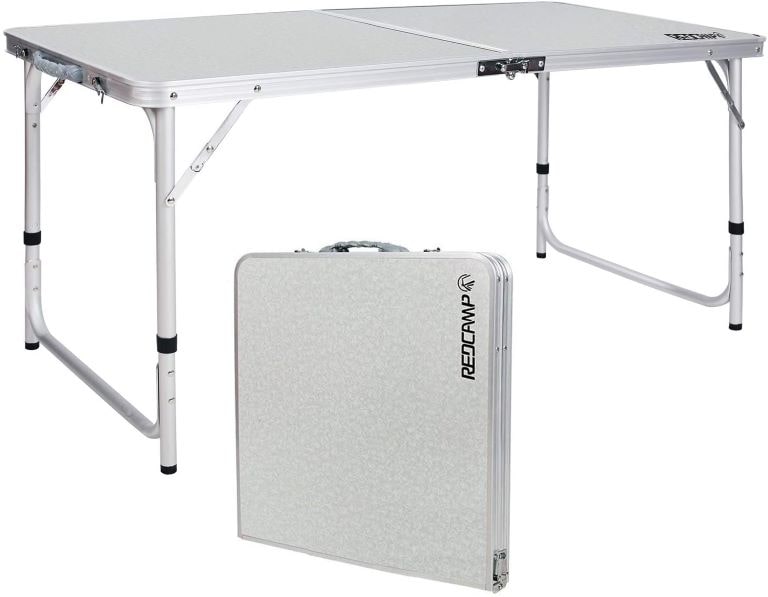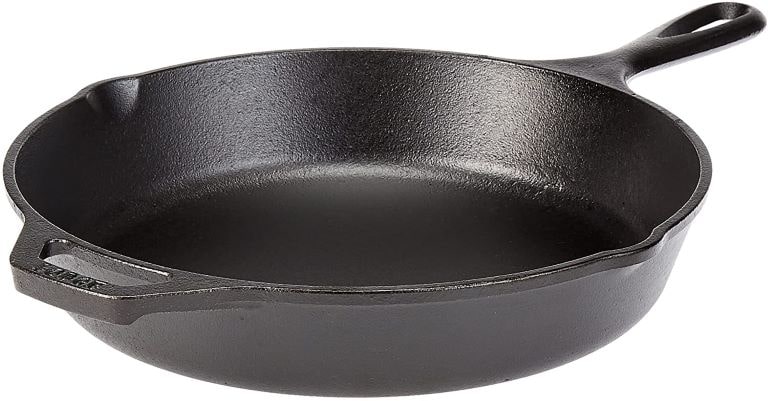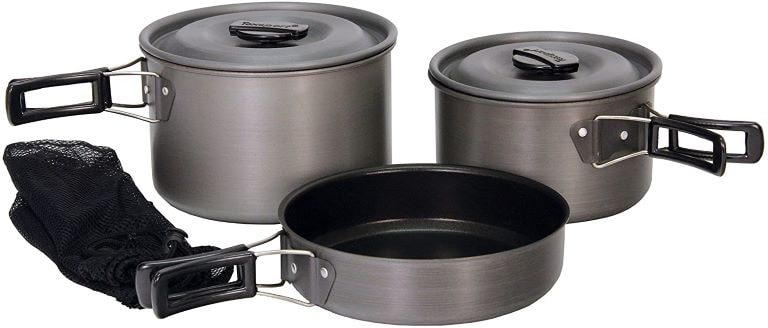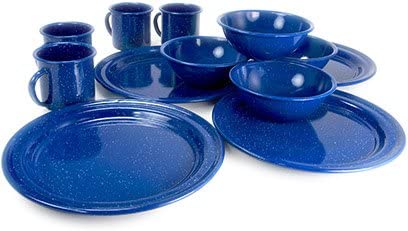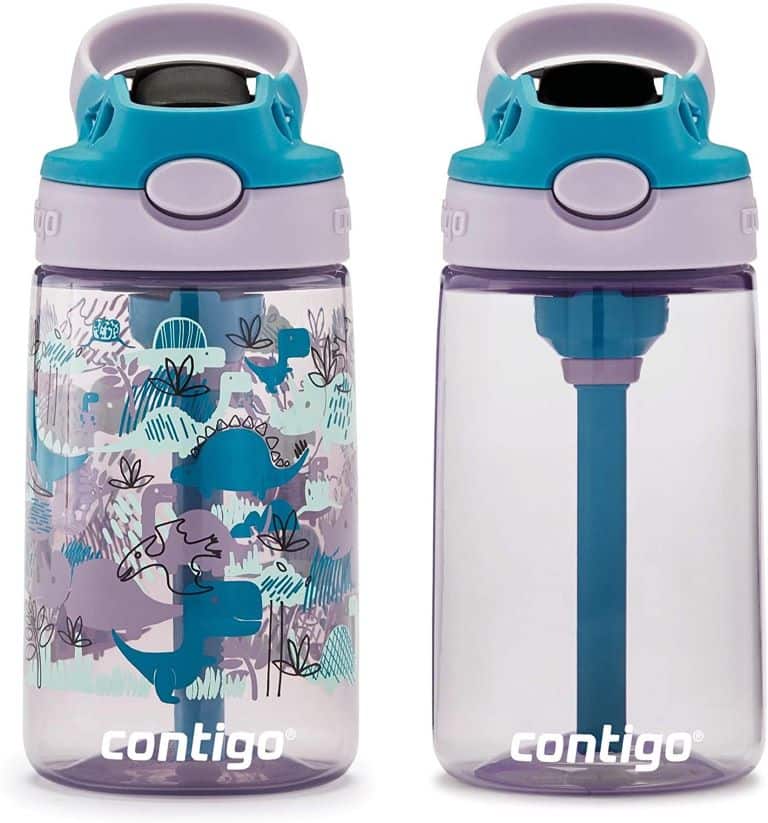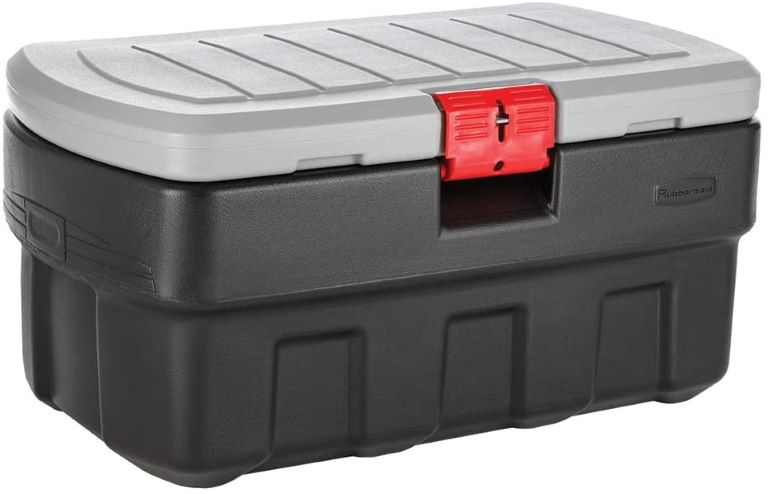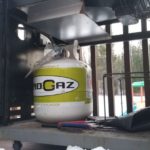When it comes to camping, there are only two types of people in this world. One will pack the car full of camp kitchen items thrown in plastic grocery bags and laundry baskets. There is no method to this person’s madness and finding the can opener will be an hour-long frustration.
The second person has everything neatly packed in separate Rubbermaid and Tupperware containers. Every container is labeled so you know exactly where to look for whatever it is you need.
There are only so many hours available in any camping trip and if you truly want to make the most of each and every one of them, then you need to be person number two. Or at the very least somewhere in between.
In this post we’re going to take a deep dive into all of the things you might need and want to make your camp kitchen practical and organized. Being prepared will make getting meals ready an enjoyable part of each day too!
Your camp kitchen area can be separated into three distinct parts; the cooking area, the dining area and the wash station.
Camp Cooking Area
If you want to make things easiest it is best to have a dedicated camp cooking area where you can prepare meals without having to move things around. If your cooking area is also used as your dining area, you’ll find yourself needing to clean up before you can even get started with meal prep. This adds valuable time and unneeded hassles.
A small table where you can chop vegetables and cut meat comfortably while standing will make all the difference so you don’t have to fumble around while trying to balance a cutting board on your lap.
A table is also a great place to put the camping stove while cooking. I’ve seen many people place it on a cooler while cooking. If you do this, you constantly have to move it to get into the cooler. Plus you’ll have a sore back from bending over as it’s not the most comfortable situation.
Dining Area
Once the food is ready, you should be able to serve it and move on to the dining area. Now, that might sound like a fancy word for camping, but all I mean is that it is really nice to have a separate setup to eat at. If you are taking the family along, it’s great to be able to sit the kids down at a nice level table with lots of room so they aren’t constantly spilling each other’s drinks.
A separate picnic table is a wonderful thing as it is usually big enough and comfortable enough to eat at for a family. A campground will normally have a picnic table at each site and you can bring along a few extra small foldable camping chairs that can be placed at the ends to fit more people. I like this one because it is high enough to sit comfortably at the table, whereas normal camping chairs would be too low for most people.
Wash Station
No matter how much gear you think you can do without, a wash station is something that you will really appreciate while camping and will not want to leave at home.
It will give you a place to soak and wash dirty dishes without having to rinse each cup and plate individually. It is also a great spot to wash food before eating it, especially if it’s stored outside near the ground. You might have some creepy crawlers that end up in the potatoes and a quick wash will rinse them away.
In addition to meal prep and washing dishes, you can keep a little bit of clean water in it at all times so you can quickly wash dirty hands and wipe up spills throughout the day.
Camp Kitchen and Cook Stations – the all-in-one Commercial Options
Camping equipment has come a long way over the years and there are some really neat and innovative all in one commercial camping kitchens that make meal preparation and storage of kitchen items much more convenient.
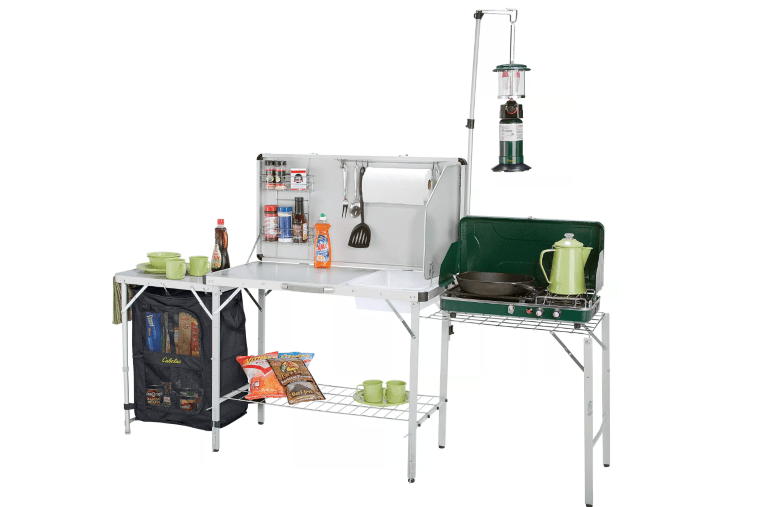
If you’re considering purchasing an all in one cook station, there are a few things you should keep in mind.
1. Portability – While you might have dreams of having a cook station with all sorts of counter tops, fold outs and storage space, you need to remember that you have to get it to the campground somehow. Finding a camping kitchen that folds down to a workable size should be the number one priority. Also look for the unit and make sure it’s light enough for you to handle.
2. Durability – Keep in mind that your camp kitchen will be spending all of its time outdoors, likely on some uneven ground. Kids will be reaching for the cereal and pulling on the countertop. It’s likely that it will get bumped around while packing and traveling. A durable camp kitchen should be made of good, strong materials that won’t bend easily. Look for heavy duty aluminum and steel to make up the majority of the camp kitchen.
3. Versatility – Of course everyone is looking for a camp kitchen that offers as much versatility as possible. Otherwise you could just bring a foldable table and be done with it. Being able to keep all of your cooking gear and utensils in one location will negate the need for searching for things when you need them. Look for an option with enough counter space to hold your grill and still be able to meal prep beside it. Maybe you want a sink to be included and built in. Being able to store your cooler underneath is also nice. These may seem like small things, but they make a big difference when you’re trying to stay organized.
Camp sinks
If you have ever gone camping without a sink, you know how difficult it can be to wash dishes after a meal or an apple after it just rolled through the dirt. Having a portable camping sink is something you will not take for granted on your next trip.
Aside from helping with meal prep and washing dishes, it will also come in handy for cleaning your hands throughout the day. If you’ve got a young family, this is absolutely essential as you clean little hands for the one thousandth time of the day.
There are plenty of different styles of camp sink and picking one will be dependent on what you need. It will also depend on how much bulk and weight you are able to lug into your site.
If you are car camping, then chances are you won’t mind bringing along a wash tub or maybe even a full size portable sink. However, if you’re backpacking, then a collapsible bucket or two might be all you’ve got room for, if even that.
Portable Camping Sinks with Running Water
A full size, portable camping sink with running water will obviously be the most convenient sink to have at the campsite. Having said that, the trouble will be in getting it there. You probably wouldn’t have room for it in the trunk of your car or even in a small SUV. But, if you can strap it down in the back of a truck, then this is an excellent option.
Portable camping sinks aren’t overly expensive and they are easy to use. Most models come equipped with a water tank, which can be operated by a foot pump. The water is pumped through a small faucet into the sink and drained to either a holding tank or a bucket placed under the drain.
One of the most convenient features of these sinks is that you don’t have to go back and forth looking for water. The holding tank is large enough to supply enough water for the day for a small family.
Once the bucket or grey water tank is full, you can just carry it (or wheel it, they are heavy) over to a dumping station within your campsite to dispose of it.
While these sinks are awesome for use at campgrounds, this is not something you will be carrying into your dispersed campsite.
Wash Tubs
One simple option for a camping sink is to use a washtub or a bucket. You may have even heard of the three bucket wash system for washing dishes while camping. It involves a bucket for soap and water, one for rinsing and one for sanitizing dishes.
In my opinion a small washtub of around 1 foot by 1 foot in size and depth is easier to work with than a 5 gallon pail. A washtub can be placed on top of a table easily and used for washing dishes. When it’s not in use you can keep plates and cutlery as well as other items in it. They also give you something extra to pack supplies in on the way out of the campsite.
You can also find camping wash tubs that have removable drains in the bottom of them so you can simply dispose of greywater without having to carry it around.
Collapsible Buckets/Tubs
To save some space, collapsible buckets or tubs are a great option. They fold down to a few inches in thickness so they can be packed away quite easily. They come in all sorts of different sizes so you can hold as much water as you think you’ll need.
Similar to regular wash tubs, there are options with removable drains so you can empty the water when finished. I really like the idea of sitting a washtub on top of a bucket and draining the water into the bucket. That way, any food or garbage that was in the water will get caught in the drain trap and can be disposed of in the garbage.
Or how about this collapsible camp sink that can also be used as a cutting board.
Camp stoves and grills
A camping stove is probably everyone’s favorite item to purchase when looking for camping equipment. There are so many things to consider when looking for a camp stove and there is literally an option for every scenario.
Are you going solo camping in the backcountry? If so, a compact solo camp stove is what you’ll want in order to reduce the load, but still be able to make coffee, eggs and bacon.
Now, if you’re not the type to hike in many miles to find a secluded campsite where you can be all alone with your thoughts, then you will most likely want something a little bigger that you can cook a meal on for a few people.
There are single burner camp stoves, two burner camp stoves, griddles, portable trailer hitch stoves and you can even take in your barbecue if you want to. And there are a number of quality companies that are making reliable camping stoves for the everyday family. You’re probably familiar with companies like Coleman and Camp Chef, but there are also others like Blackstone which have become almost cult worthy in their following.
Solo Camp Stoves
Made and intended just for the person that does want to take a backpack and head out into the deep woods alone, a solo camp stove is extremely versatile despite its size.
Solo camp stoves are extremely lightweight, often weighing around only 2 pounds. Plus, they are so small and compact that they can easily fit inside a backpack with all of the other needed gear for a multi day trek. These single burner stoves often burn wood for the heat source so they do require gathering some good, small wood to burn and a little cleanup of soot and ash after use. However, being able to use wood negates the need to bring along any other form of fuel, so no worry about added weight from those items.
Single Burner and Double Burner Camp Stoves
The only difference between a single burner and double burner camp stove is just that, the number of burners available for cooking. Both options will use some form of fuel for the heat source, whether it be butane, propane or some other option. A double burner will be bigger and heavier than its counterpart. For this reason, a double burner camp stove will be able to cook more food at a time.
Choosing between the two will be a matter of your needs and the amount of space you have for packing and camp kitchen setup. For single burner options I really like the Chef Master portable butane stove because it’s got excellent heat output at 15,000 BTU’s. For double burner camping stoves my preference is the classic Coleman propane camp stove series for it’s good price and reliable quality. Having said that, there are many good options on the market.
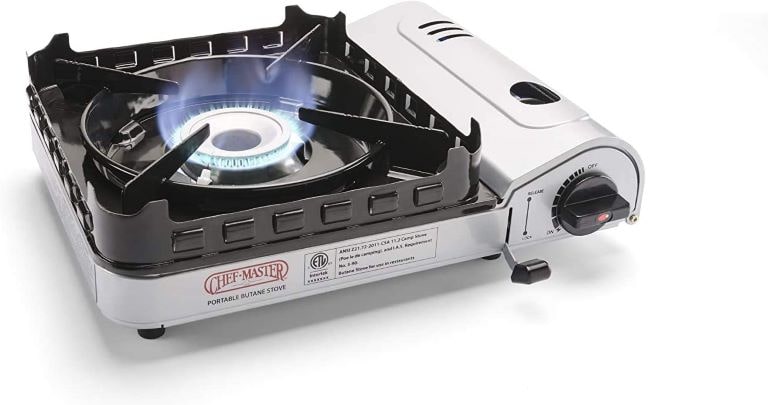
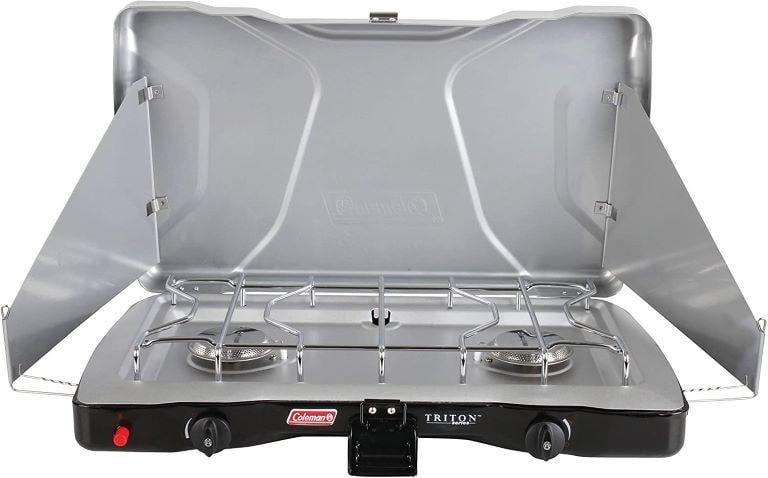
Camping Griddle
Maybe I just wasn’t paying attention before, but I have really noticed that camping griddles have become extremely popular in recent years. There are large Facebook groups dedicated to certain products like the Blackstone Grills and they have thousands of members discussing recipes, maintenance and everything in between on a daily basis.
When you dive in a little deeper, it is easy to see why they have such a following. They offer a large, flat surface for cooking so there is no wasted space and you can cook up a lot of food at once. There is also no need to bring any frying pans since the griddle surface does the job for you.
There are both stand-alone options as well as tabletop. These are larger, heavier cook stoves and are usually fueled by full size propane tanks. Because of this, they are best used for car camping and RV camp trips. Check out this tabletop Blackstone griddle which is one of the most popular on the market.
Trailer Hitch Grills
Perfect for a day at the beach, but also for car campers, a trailer hitch grill is more compact than a full size barbecue as it doesn’t require the stand. If you can drive right up to your campsite then this grill might be the best choice for you. Oftentimes, models are detachable from the hitch bracket so you can use it as a tabletop option as well.
Cooking on a Fire Pit vs Camp Stove or Grill
Of course, you can choose to skip the camping stove altogether and opt to cook over an open campfire instead. If you do, you can reduce the amount of camp kitchen space you need since you won’t need an area for the grill or propane tanks to sit. Not needing space for large kitchen gear also means you can pack lighter and save room for other equipment.
Live fire cooking, also known as cowboy campfire cooking, comes with it’s own unique catalog of equipment. You could go with a simple cast iron or stainless steel grill placed over the fire pit. That is most likely the most basic from of camp cooking.
But then there are other options like fire pit swivel grills that allow you to move food in and out of the fire with ease. A similar piece of equipment to the swivel grill is a tripod camping grill swing. They are supported by a chain connected to tripod legs. Just as the name suggests, the grill will swing on the chain so you can move it around. In addition the grill is height adjustable so you can move it up or down to get the perfect temperature.
These are just a couple of tools that will help to make campfire cooking a success. There are tons of others to be found as well.

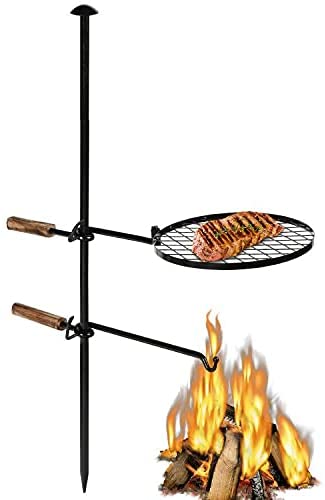

Camping Tables
A sturdy camping table will give you a solid place to prepare meals and place your camping stove. There are plenty of foldable tables that are quite compact and can be placed in the trunk of a car without taking up too much space. Look for something with durable legs that won’t bend easily.
If you’re camping at a campground, then chances are there will be a picnic table available for your site. It’s best to leave that for eating meals and playing games at though. It will get full quickly if you try to prepare food plus eat at it. Brining along a separate camping table allows you a place to lay out food so everyone can take what they want and head over to the picnic table to eat.
Camping Pots and Pans
Unless you plan to grill burgers and hotdogs over the open campfire for every meal, there’s a good chance you’ll need to bring along a few pots and pans. The size and shape of these objects make them awkward for packing and they do end up taking up a lot of space. They also add quite a bit of weight to your gear. Before packing up your whole assortment of pots and pans for your camping trip, think about what you’ll be cooking and bring only what you need.
If you watch any YouTube video about camp cooking, you’re sure to notice a trend in the materials used. Cast iron is super popular in the camping world for various reasons, including it’s durability, heat retention and ability to be placed right on top of the flames and hot coals without melting.
Cast Iron Skillets
A well seasoned cast iron skillet will last you a lifetime while adding great flavor to your camp meals. They are perfect for frying bacon and eggs, vegetables and anything else that can be cooked in a shallow dish. The most important advice I can offer for taking care of cast iron skillets is to never wash it with soap and always keep it well seasoned with your favorite cooking oil. if you pay attention to the general maintenance of your cast iron skillet, you will have a non-stick pan that will last a lifetime. Lodge Cast Iron is one of the most popular brands and they’ve been making cast iron cookware for over 120 years. But they aren’t the only company in town. There are plenty of quality companies to discover.
Cast Iron Dutch Oven’s
Another favorite of cowboy campfire cookers and veteran campers alike is the cast iron Dutch Oven. A Dutch Oven can be used to cook up some hearty stews and soups. But that isn’t all. You can even bake a cake in these versatile items. All you need to do is place the Dutch Oven right on top of the hot coals, surrounding it with some more hot coals around the sides. Place a shovel full of coals on the lid as well, and you’ve effectively made yourself an oven, being heated from every direction.
Titanium Pots and Pans
While cast iron is a great and popular choice, it isn’t for everyone. If you prefer to keep your camping gear lightweight, then a set of titanium pots and pans will be your best option. You can still boil water and soup. Plus you can fry your bacon and eggs. Just keep this camp kitchen gear out of the direct flames of a campfire or they can be damaged and discolored.
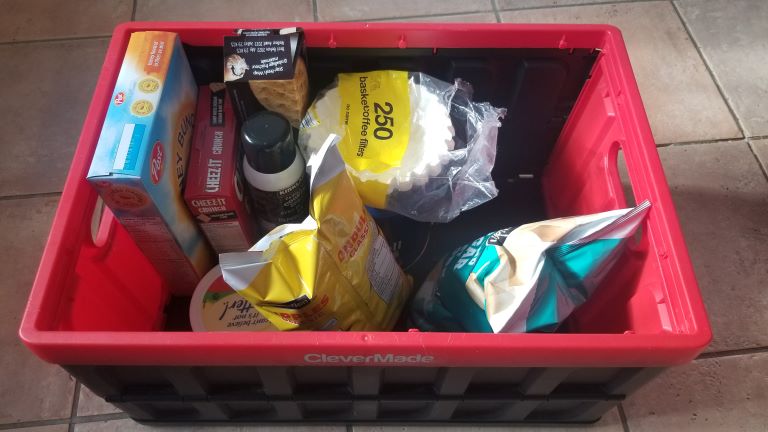
Food Storage
Whether you are camping for a day or a week, you will need something to protect your food from animals, the elements and from going bad. Separating the dry non-perishable items from the perishables is step one. Keeping everything in an organized state so you don’t have to dig to the bottom of the cooler on day one is just as important. If you can keep a well organized system, you will have a more enjoyable camping trip.
Camping Coolers
A good cooler is worth its weight in gold as it will be the most valuable piece of equipment in ensuring that perishable foods don’t spoil by the second day of your trip.
Soft coolers are perfectly fine for a day at the beach, but they can’t keep the heat out long enough to be effective on a multi-day camp trip.
A good, hard cooler will hold ice for at least a couple of days. A Yeti or Chilly Moose Cooler can do even better than that. Many of those top models can keep your food cold for 4 or 5 days as long as you keep them in the shade and minimize the amount of time they’re open. When packing your cooler for the trip, be aware of which foods are going on the bottom and which ones should be closer to the top. This article from the experts at Fresh off the Grid will have you packing your cooler like a pro so you make the most out of it and keep foods cold for longer.
If you’re looking for an excellent cooler at a better price than the top brands, then check out the RTIC line. The reviews are just as good, but at a fraction of the price. Don’t just believe me though. Check out this Reddit conversation and see how many people suggested RTIC.
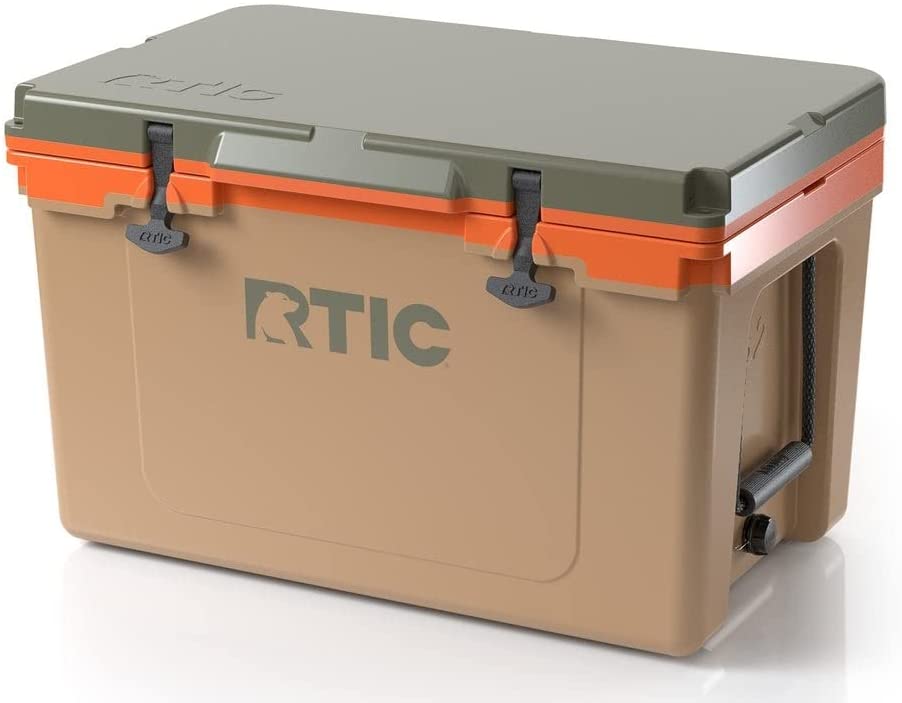
Bring only what you’ll use on your camping trip
You’ll also want to think about how much food you really need to bring so you aren’t over packing and risking spoiling food for nothing. Planning your meals ahead will help to make sure you are only bringing the things you need. Once you know what you’ll be bringing, you can size your cooler accordingly.
A separate cooler for drinks
If you are car camping and plan to bring a lot of drinks along as well, then you might be best to take two coolers on the trip. A drink cooler gets opened a lot throughout the day. Each time you open the cooler, cold air escapes and warm air enters, speeding up the ice melting process. No cooler can effectively keep ice frozen with the lid open so it is a great idea to keep meats, milk and other perishable items in a separate cooler that only gets opened a couple of times a day.
Camp Utensils and Dishware
A lot of people opt for paper plates and single use plastic forks and knives when it comes to dinnerware for a camping trip. While that might seem to be the most convenient option, cutting a chicken breast with a plastic fork while the juices soak through your paper plate can be really quite irritating. Plus single use plastics are not environmentally friendly and so you will need to pack them up and take them home to throw them out.
If you want something a little more sturdy and eco-friendly at the same time, then there are plenty of options available. Bamboo cutlery is an excellent, strong and biodegradable option. Forks, knives and spoons can all be found made from bamboo and other wood products.
There are also lots of durably made multi tools that are geared specifically for camping and are an all-one-option.
alternatives to paper plates and bowls
A light weight, enamel coated dinnerware set complete with bowls, plates and cups is also another option that won’t break if dropped and doesn’t add a lot of weight to your gear. They are easy to clean as well and last a long time. Here’s a full set from GSI Outdoors made for 4 people.
Drinking Essentials
Similar to dinnerware and cutlery, you’ll need to decide what you want to bring along to drink from. Easy to clean, lightweight cups made from titanium are one option that again won’t break if they fall to the ground. A few styrofoam cups are ok to bring along in a pinch, but they only get used once and then need to be taken home and thrown in the dumpster.
Aside from the material you choose to take along, there are a few more decisions to be made for the type of drinkware you need. Will you be drinking cold beverages, hot beverages or maybe both? Do you enjoy a hot cup of coffee in the morning while you watch the sunrise? There is no one size fits all option, but there are plenty of useful options available.
Cups
If you have kids, then you know just how many cups they can go through in a single day. It’s absolutely insane! You could take a package of styrofoam or single use plastic cups, but they will get wasted in a hurry.
For camping trips, it will be much better to take along a few multi-use plastic cups that won’t break when they’re dropped. Cups with lids and straws are also excellent for kids and yourself. There is less chance of spilling, but a lid will also keep dust and dirt from getting into your drink while spending time outdoors.
Or if you really want to reduce the amount of space taken by drinkware, silicone collapsible cups are perfect for day hiking with the kids and they can even fit in your pocket. They also come with lids, making them a great item for lunch in the forest.
Mugs
When it comes to camping mugs, I’m a big fan of using travel mugs for the simple fact that they are convenient and mostly spill proof. Further to that, travel mugs aren’t just made for your morning coffee anymore and many of the best quality ones can keep your drinks cold for a long time too. If I’m heading out early in the morning and don’t want to drink my coffee right away, I can pour it into my Yeti mug and it will still be hot a couple of hours later.
Water Bottles
A good water bottle also goes a long way when camping. Everyone can have their own and being able to close them so you can drink from it throughout the day is helpful, particularly for kids. You can have children sizes for the kids and adult sizes for you. There are way too many options to list, but a good spill proof water bottle is perfect for having around the campsite.
Coffee Maker
Making coffee while camping is an art form in itself that can be done using multiple different methods. You probably make coffee at home the same way every day. Whether you use a percolator, a keurig, instant coffee or if you pick up a cup on your way to work, it’s more or less the same cup of coffee day in and day out.
You can add a lot of variety while out on a camping trip. There are at least ten different ways for making coffee in the wild. You could use a French press, single packets or maybe try your hand at brewing up your very own cowboy coffee.
Camp Kitchen Storage
As you can imagine, keeping camping kitchen items neatly stored so they are easy to find is one of the biggest challenges when packing for your camping trip. You start off with a plan, but then quickly end up mixing things together at the last minute. When you try to find something at the campsite, it becomes a bit of a mess and you’re left with it for the duration of the trip.
Luckily, there are tons of helpful storage items that will keep things organized so you’ll know just where to look for whatever it is you need.
Camp Storage Bins
A quality, durable tote or storage bin for larger camp kitchen items is worth every penny. I like to keep pots, pans, paper towels and other large, awkwardly shaped camping gear in totes. Look for something with latches that close completely and lock tight so it won’t open up on the drive. If you get something strong enough, you can even use it as a bench or extra table area for making meals.
Tupperware Containers
Smaller kitchen equipment like cutlery and napkins can be stored in Tupperware containers before placing them in a storage bin. That way they won’t be mixed around all over the place when you get to camp. Obviously, Tupperware is also great for storing chopped veggies and other foods before packing them in the cooler. It’s much easier to stack a few Tupperware containers in the cooler than to throw in bags of veggies that will end up soaked when the ice melts.
DIY Camp Kitchen Storage
There are so many creative ways to reusing regular kitchen and other household items to store foods for camping. You can use an old ketchup bottle to hold pancake batter so it’s ready to just squirt into the pan on your camping trip. Everyone has probably seen the coffee can camping hack to store cutlery or toilet paper. These are just a few of the many, many neat do it yourself camping storage hacks.
Check out this post to see so many more DIY camping storage hacks.
Camping Water Storage
Each person will use an average of around 2 gallons of water per day while out camping. While that doesn’t seem like a huge amount, for a couple of adults and a small child, you’ll want to have approximately a 5 gallon pail worth of water for each day. So how are you going to store it?
A hard water cooler is one option that does store around 5 gallons of water. You can place it on a table and use it for drinking as well as washing hands.
A Scepter water container is similar to a jerry can and is food grade with a convenient handle that makes it easy to carry. You could use it to fill up the water cooler or use it directly.

Garbage and Recycling
Nobody likes dealing with the mess and garbage from a camping trip. It is just one of those unavoidable things that you need to prepare for though. Not only do you have to think about how you’re going to pack it up to take it home, but also how you’re going to keep animals out of it while at the campsite. The last thing you want is to wake up every morning to find that a squirrel or raccoon tore through the garbage the night before.
look for campground disposal bins
If you’re staying at a campground, then chances are that you will be able to dispose of garbage bags in a dumpster there. If that is the case, then it’s best to throw the bag out each day before heading to bed. That will keep the nocturnal animals from paying you a visit in the middle of the night. Also, if you’re leaving the campsite for any duration of time during the day, take the trash out first as squirrels and crows are just waiting for you to leave the garbage unattended.
If you don’t have the option of throwing out garbage bags daily, then you can either place the bag in your vehicle at night or get something a little more animal proof like a popup zip up garbage can or even a bear safe garbage can. In addition to keeping animals out, a garbage can will hold the bag open, making it easier to throw garbage in it throughout the day.
If you do need to put the garbage in the vehicle for the night, putting a tarp or plastic tray underneath the bag will keep potential leaks from soaking into the carpet and leaving an awful smell.
DIY Camping Kitchens
A quick Google search will turn up hundreds of results for different styles of DIY camp kitchens made from old dressers, resin shelf units and so much more. The great part about a DIY kitchen is that you can literally make anything you can think of. If you want extra storage for spices and condiments, you can make it. If you need to have a sink and some extra counter space, no problem. Enjoy this list of 28 super creative DIY camp kitchen projects.
Kitchen Cleaning Essentials and Products
You’ll only need a couple of items to keep your camp kitchen clean and sanitary. Some biodegradable dish soap for washing dishes is the first thing you should pack. Regular dish soap can be harmful to waterways and the local ecosystem so it’s best to leave it at home.
The second thing you’ll need is a few dishcloths so you have plenty to wash dishes and wipe down table surfaces.
Make sure to wipe down the camp table plus any cutting boards that were used for cutting raw meat. You definitely don’t want that to spoil in the sun and cause a stench for the campsite.
Food Preparation Miscellaneous
There are absolutely tons of miscellaneous food prep items that you might want to bring along to make meal preparation easier. Here are a few of them that we always bring along and a few others that would definitely come in handy, but aren’t essential.
- Cutting Boards
- Sharp Knives
- Aluminum Foil
- Lighter
- Tongs
- Spatula, Wooden Spoon, Ladle
- Can Opener
- Table Cloth
- Oven Mitts/Work Gloves
- Roasting Sticks
- Pie Iron
- Garbage Bags
Camp Kitchen Organization
The number one purpose to having an efficient camp kitchen setup is to stay organized and make meal preparations easier and faster. Here are a few extra tips to making sure that you don’t lose items or forget something before heading out.
Keep kitchen items separate from others when packing
Like I mentioned before, you’ll start off with a solid plan for organization when packing your camping gear. Then all of a sudden, at the end you will start throwing things you forgot into any bin with a little room left. Suddenly, you’ve got the cutlery in your duffle bag and a baseball glove in the grill. Avoid that temptation and make sure to keep your kitchen items all packed together. It might take a couple of extra minutes while packing, but it will save you time and frustration at the campground.
Put things back where you got them
If only you could teach your kids this lesson. When you take something out, put it back where you got it so that you can find it again the next time you need it. If everything is put back where it is supposed to go, it will also make unpacking at home that much easier.
Plan your meals ahead and pack only what you need
There are so many times where people overestimate the amount of gear and food that they need for a weekend trip. If you’re going for a couple of days, you only need to bring 2 breakfast meals, 2 lunch meals, 2 dinner meals and a few snacks for in between. Think ahead and bring only the items that you need for those meals. There is no use in over packing and having to lug it all back out at the end of the trip
Keep a list
Making a list of all of the items in each storage tote and taping it to the side of the bin will make it that much easier to identify what is in each bin. You also won’t forget any items when packing since you’ll know exactly what you always bring along. As items break or need replacing, you can make a little note beside the item on the list.
Keep it simple
Camping is supposed to be a fun and light activity that reduces stress. Don’t overthink it and don’t complicate it by packing every item from your kitchen drawer. Take along the essentials that you’ll use every day and the things that you can’t do without. If you’re missing something that would have been nice to have, but not something you absolutely need, then you’ll make do and find another tool to get the job done.
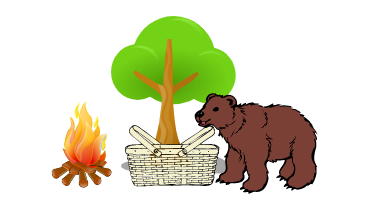
Keeping Animals and Bugs Away
The best way to keep animals and insects away from your campsite is to stow away anything that would attract them. Keeping food in sealed containers and cleaning up after meals is good practice for every camp trip. Store your cooler some distance away from the tent at night just in case it does attract larger animals.
Washing dishes after every meal will keep crumbs and other foods away that would otherwise attract chipmunks, wasps and other small critters.
We love writing about the things that make a real difference in your outdoor experience. Some of the links in this post are affiliate links in which case we may earn a small commission at no extra cost to you if you make a purchase. We truly appreciate you taking the time to read our content and hope it has added value to your next camping and outdoor adventure.

